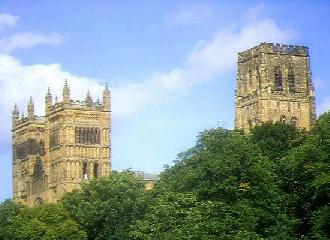 |
 |

Durham Cathedral
[Wednesday - 10/26/94] When William the Conqueror finally took control of Durham he appointed a Norman called William Walcher as Durham’s first Prince Bishop by combining the powers of the Bishop with those of the Earl of Northumbria. Walcher’s time as a Prince Bishop, though, was characterized by weak leadership and ultimately resulted in him being murdered at Gateshead in 1081. He was replaced by a new bishop called William St. Carileph, who was the man responsible for building the present cathedral.
Carileph designed the greater part of the Cathedral of Durham as it stands today and began its construction in the year 1093. The building was completed to the bishop’s designs in more or less forty years. Unfortunately, Carileph did not live to see the completion of his cathedral in 1135.
The Ribbed vaulting at Durham was, in its time, technically far more advanced than any vaulting to be found anywhere else in Britain or on the continent. In fact it is quite possible that Durham Cathedral was the first building in Europe to receive ribbed vaulting. The Cathedral at Durham is also important for the flying buttresses, a feature invented by the Norman masons at Durham.
In later years, two major additions were made to the cathedral. The first was the Galilee Chapel by Bishop Hugh Le Puiset (1153-1195). The Galilee Chapel is at the western end of the cathedral and is situated right at the top of the gorge formed by the River Wear where it is overshadowed by the cathedral’s twin towers. It is famous as the home of the black marble-topped tomb of The Venerable Bede (673-735 A.D), who was the first historian of England. His bones were brought to Durham from the ruins of Jarrow monastery in 1020 A.D.
The Galilee Chapel is also known as the Lady Chapel, as it was once the only part of the cathedral that could be entered by women according to the rules of the Benedictine order of monks. So strict was the rule against women entering the cathedral that in 1333 when Queen Philippa, wife of Edward III entered to find sleeping quarters in the cathedral, she was forced to sleep elsewhere.
The large Chapel of the Nine Altars at the eastern end of the cathedral was begun during the episcopacy of Bishop Richard le Poore (1228-1237), who was also associated with the building of Salisbury Cathedral. This new chapel provided more space for the increasing number of visiting pilgrims who packed the aisles and choir of the cathedral to view the shrine of St. Cuthbert.
Without doubt the most beautiful feature of the Chapel of the Nine Altars is the huge rose window which was originally made in the fifteenth century by Richard Pickering of Hemingbrough and reconstructed in the eighteenth century by James Wyatt. The Rose is ninety feet in circumference with a central core depicting Christ surrounded by the twelve apostles. Inside the cathedral, the Chapel of the Nine Altars lies just to the east of an elevated feretory (a chapel for saint’s relics) in which we find the tomb of Saint Cuthbert.
In medieval times, Durham Cathedral was one of the greatest centers of pilgrimage in England and the chief reason for pilgrimage was the rich and glorious shrine of Saint Cuthbert. Today the simple grey stone tomb inscribed ‘Cuthbertus’ is all that remains of the shrine after the Dissolution of the Monasteries in the sixteenth century.
St. Cuthbert’s tomb and feretory are hidden from the Choir and the Nave to the west by the magnificent fourteenth century Neville Screen, which was at one time decorated with 107 alabaster figures. The screen was donated to the cathedral by John, the 5th Lord Neville (d. 1388). John Neville’s tomb lies in the south aisle of the Nave where he is accompanied by his wife Matilda. The tomb of John’s father Ralph Neville is also in the cathedral. It was Ralph who successfully led the English into victory over the Scots at the Battle of Neville's Cross just outside Durham in 1346. As an honor for the victory he became the first layman to be allowed burial in the cathedral.
|
Last modified on Wednesday, November 26, 2008 URL: http://www.housecorvus.org/dur.htm Copyright © 2000-09 House Corvus. All rights reserved. Design and hosting by Bran Trefonnen. | |